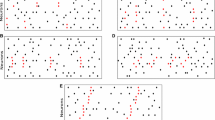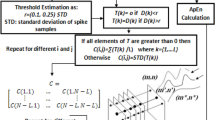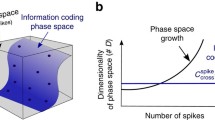Abstract
The aim of spike sorting is to reconstruct single unit spike times from extracellular multi-unit recordings. Failure in the identification of a spike (false negative) or assignment of a spike to a wrong unit (false positive) are typical examples of sorting errors. Their influence on cross-correlation measures has been addressed and it has been shown that correlation analysis of multi-unit signals may lead to incorrect interpretations. We formulate a model to study the influence of sorting errors on the significance of synchronized spikes, and thus are able to study if and how the significance changes in case of imperfect sorting. Here we explore the case of pairwise analysis of simultaneously recorded neurons. Interestingly, a decrease in the significance is observed in the presence of false positives, as well as for false negatives. Furthermore, false negative errors reduce the significance of synchronized spikes more strongly than false positives. Thus, conservative sorting strategies have a stronger tendency to lead to a loss of the significance of synchronization. We demonstrate that a detailed understanding of sorting techniques and their possible effects on subsequent data analyses is important in order to rule out inconsistencies in the interpretation of results.
Similar content being viewed by others
References
Aertsen AMHJ, Gerstein GL, Habib MK, Palm G (1989) Dynamics of neuronal firing correlation: Modulation of effective connectivity. J. Neurophysiol. 61(5): 900–917.
Bar-Gad I, Ritov Y, Vaadia E, Bergman H (2001) Failure in identification of overlapping spikes from multiple neuron activity causes artificial correlations. J. Neurosci. Methods 107(1–2): 1–13.
Bedenbaugh P, Gerstein GL (1997) Multiunit normalized cross correlation differs from the average single-unit normalized correlation. Neural Comput. 9(6): 1265–1275.
Brody CD (1998) Slow covariations in neuronal resting potential can lead to artefactually fast crosscorrelations in the spike trains. J. Neurophysiol. 80: 3345–3351.
Fee MS, Mitra PP, Kleinfeld D (1996) Variability of extracellular spike waveforms of cortical neurons. J. Neurophysiol. 76(6): 3823–3833.
Gerstein GL (2000) Cross-correlation measures of unresolved multi-neuron recordings. J. Neurosci. Methods 100(1–2): 41–51.
Grün S, Diesmann M, Aertsen A (2002a) Unitary events in multiple single-neuron spiking activity: I. Detection and significance. Neural Comput. 14(1): 43–80.
Grün S, Diesmann M, Aertsen A (2002b) Unitary events in multiple single-neuron spiking activity: II. Nonstationary data. Neural Comput. 14(1): 81–119.
Grün S, Diesmann M, Grammont F, Riehle A, Aertsen A (1999) Detecting unitary events without discretization of time. J. Neurosci. Methods 94(1): 67–79.
Grün S, Riehle A, Diesmann M (2003) Effect of cross-trial nonstationarity on joint-spike events. Biol. Cybern. 88(5): 335–351.
Harris K, Henze D, Csicsvari J, Hirase H, Buszàki G (2000) Accuracy of tetrode spike separation as determined by simultaneous intracellular and extracellular measurements. J. Neurophysiol. 84(1): 401–414.
Hyvärinen A, Oja E (2000) Independent component analysis: Algorithms and applications. Neural Networks 13(4–5): 411–430.
Lewicki MS (1998) A review of methods for spike sorting: The detection and classification of neural action potentials. Network 9(4): R53–R78.
Perkel DH, Gerstein GL, Moore GP (1967b) Neuronal Spike Trains and Stochastic Point Processes. II. Simultaneous spike trains. Biophys. J. 7(4): 419–440.
Pipa G, Diesmann M, Grün S (2003) Significance of joint-spike events based on trial-shuffling by efficient combinatorial methods. Complexity 8(4): 79–86.
Pipa G, Grün S (2003) Non-parametric significance estimation of joint-spike events by shuffling and resampling. Neurocomputing 52–54: 31–37.
Pipa G (2001) Entwicklung und Untersuchung einer nicht-parametriscchen Methode zur Schätzung der Signifikanz zeitlich koordinierter Spike-Aktivität. Diploma thesis, Physics, J-W Goethe Univ, Frankfurt/M, Germany.
Pipa G, van Vreeswijk C, Grün S (2006) Impact of spike-train autostructure on probability distribution of joint-spike events (in preparation).
Pouzat C, Delescluse M, Viot P, Diebolt J (2004) Improved spike-sorting by modeling firing statistics and burst-dependent spike amplitude attenuation: A Markov chain Monte Carlo approach. J. Neurophysiol. 91(6): 2910–2928.
Pouzat C, Mazor O, Laurent G (2002) Using noise signature to optimize spike-sorting and to assess neuronal classification quality. J. Neurosci. Methods 122(1): 43–57.
Quirk MC, Wilson MA (1999) Interaction between spike waveform classification and temporal sequence detection. J. Neurosci. Methods 94(1): 41–52.
Quiroga RQ, Nadasdy Z, Ben-Shaul Y (2004) Unsupervised spike detection and sorting with wavelets and superparamagnetic clustering. Neural Comput. 16(8): 1661–1687.
Riehle A, Grammont F, Diesmann M, Grün S (2000) Dynamical changes and temporal precision of synchronized spiking activity in monkey motor cortex during movement preparation. J. Physiol. (Paris) 94(5–6): 569–582.
Riehle A, Grün S, Diesmann M, Aertsen A (1997) Spike synchronization and rate modulation differentially involved in motor cortical function. Science 278(5345): 1950–1953.
Schmitzer-Torbert N, Jackson J, Henze D, Harris K, Redish AD (2005) Quantitative measures of cluster quality for use in extracellular recordings. Neuroscience 131(1): 1–11.
Takahashi S, Anzai Y, Sakurai Y (2003) Automatic sorting for multi-neuronal activity recorded with tetrodes in the presence of overlapping spikes. J. Neurophysiol. 89(4): 2245–2258.
Wehr M, Pezaris JS, Sahani M (1999) Simultaneous paired intracellular and tetrode recordings for evaluating the performance of spike sorting algorithms. Neurocomputing 26–27: 1061–1068.
Wood F, Black MJ, Vargas-Irwin C, Fellows M, Donoghue JP (2004) On the variability of manual spike sorting. IEEE Trans. Biomed. Eng. 51(6): 912–918.
Zhang PM, Wu JY, Zhou Y, Liang PJ, Yuan JQ (2004) Spike sorting based on automatic template reconstruction with a partial solution to the overlapping problem. J. Neurosci. Methods 135(1–2): 55–65.
Author information
Authors and Affiliations
Corresponding author
Additional information
Action Editor: John P. Miller
Rights and permissions
About this article
Cite this article
Pazienti, A., Grün, S. Robustness of the significance of spike synchrony with respect to sorting errors. J Comput Neurosci 21, 329–342 (2006). https://doi.org/10.1007/s10827-006-8899-7
Received:
Revised:
Accepted:
Published:
Issue Date:
DOI: https://doi.org/10.1007/s10827-006-8899-7




